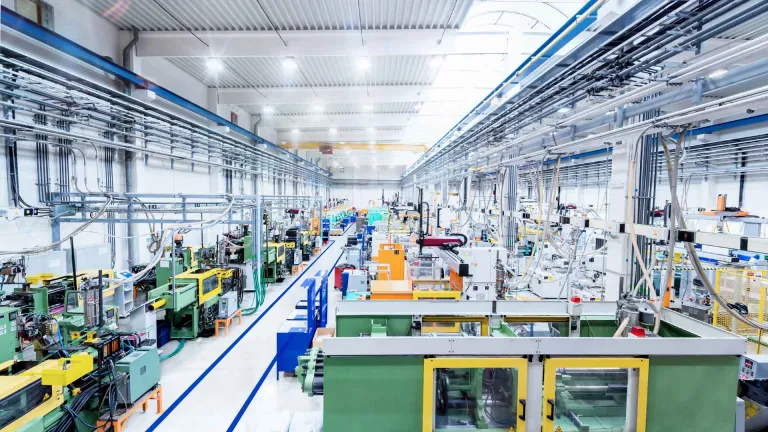The Data Revolution
Manufacturing industries are creating more data than ever before – but how can they manage and monetize this data?

In the flood of data, does your business sink or swim?
What’s happening?
The volume of data is exploding. Between 2020 and 2025, global data creation is projected to grow to more than 180 zettabytes– or roughly 180 trillion gigabytes. To put that in perspective, a single zettabyte is equivalent to about 250 billion DVDs.
This rapid rise is the result of a variety of factors as the world becomes ever more digital, but the proliferation of IoT devices and other digital solutions across private and public spaces is a primary driver.
With the rise of 5G networks, running roughly 100 times faster than current wireless communications and able to support up to a million IoT devices per square km, we are entering a new era of digital transformation, marked by the ubiquity of big data and smart manufacturing.
Curious about how other manufacturing industries respond?
Respond to today's challenges with our bespoke solutions
Why does it matter?
Data hugely enhances a manufacturer’s ability to manage and improve their operations. It enables the spread of increasingly advanced manufacturing techniques, allows machinery to be continuously monitored and serviced remotely, and through AI and predictive maintenance can help future-proof the factory floor.
Data-based approaches will also be crucial to meeting sustainability goals over the next thirty years. For example, in the aviation industry digitalization and data is seen as critical to decarbonization, helping develop the next generation of low-carbon aircraft technology.
Data manipulation is even changing the relationship between consumer and product. Connected devices are shifting the point of sale and encouraging service-based business models, where a product is continuously updated and improved digitally.
However, effectively leveraging all this data means finding it first. Industrial data is often siloed and can come in lots of different forms and sets. Cleaning, compiling, and standardizing the enormous volume of raw data will be imperative over the next decade.
Furthermore, new computational solutions, like Edge Computing, will also be needed to process all this raw data. “Edge Computing helps reduce the burden on centralized servers,” says Sophie Proust, Industry Market Intelligence Director, Dassault Systèmes. “It moves some computation on-site, reserving only the most complicated tasks for centralized cloud servers, and reducing overall system strain.”
And there are, of course, security and sovereignty considerations. According to research from Oliver Wyman, 92% of the western world’s data is stored in US-based data centers. All this must be accounted for if the energies of the data revolution are to be harnessed safely and effectively.

How can I prepare?
Separating the signal from the noise and establishing a clear-sighted view of your data landscape is priority number one for the would-be data-powered manufacturer. Consider the three Cs:
1. Collect your data and make it accessible and readable
2. Classify this data into a usable database structure
3. Consolidate your data on a single, centralized platform
By bringing your operational and manufacturing data together and making it easily accessible to all stakeholders, you can encourage greater discovery and collaboration. It creates a virtuous circle of innovation where each new piece of information inspires new ideas that provide new information.
When manufacturers get this right, it can inform every step of the value chain. For example, Toyo Tire used the 3DEXPERIENCE® platform to pull relevant product data from multiple organizational siloes, consolidate and centralize it, and then apply analytics in a targeted way that drove real innovation across their product range.
“During the design phase, past design data, test results, simulation results and reports are very important,” says Katsutoshi Ohishi, Deputy Division General Manager of the Digital Innovation Division, Toyo Tire. “By utilizing the 3DEXPERIENCE® platform, we can link all this data, improve the design, and make the end-to-end process more efficient.”
We are already in the middle of a data revolution. How manufacturers successfully harness it will define how much they innovate in the years ahead. As Hal Varian, Chief Economist at Google, argued: “The ability to take data – to be able to understand it, to process it, to extract value from it, to visualize it, to communicate it – is going to be a hugely important skill in the next decades.”
“Simply managing data does not increase its value. I think that linking it all together will further enhance the value of that data,” says Ohishi. Deputy Division General Manager of the Digital Innovation Division, Toyo Tire.
Other Trends
Discover more with our Manufacturing Industries
- Aerospace & Defense
- Consumer Packaged Goods & Retail
- Home & Lifestyle
- High-Tech
- Industrial Equipment
- Marine & Offshore
- Transportation & Mobility
THE WORLD NEEDS MANUFACTURERS
A MANIFESTO FOR CHANGE













